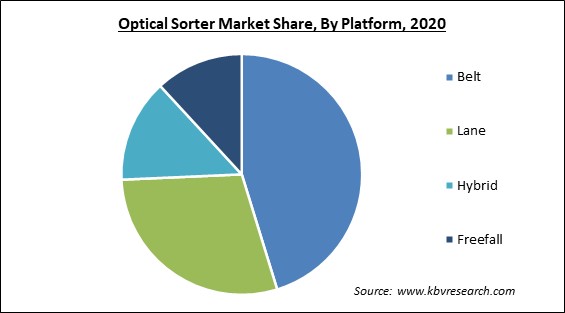
The Global Optical Sorter Market size is expected to reach $3.8 billion by 2027, rising at a market growth of 9.3% CAGR during the forecast period.
Optical sorters are a group of automated specialized systems that use cameras and laser beams in order to automate the procedure of sorting solid goods. Agricultural seeds, coffee, fruit, cereals, confectionery, nuts, meat, and seafood, as well as recycling materials such as plastic, metal, organic waste, and paper; and mining materials including precious metals and industrial minerals are all sorted using the optical sorter. An optical sorter has a number of advantages, including increased productivity, the production of high-quality commodities, and lower labor expenses.
The feed system, image processing unit, optical system, and separation system unit are the major components of an optical sorter. In order to disperse the material into a single layer, the feed system is commonly used to feed the high-speed conveyor belt. To detect the substance, it is accelerated and examined by numerous cameras or sensors. Some of the light is absorbed by the materials on the belt as the material passes under the light, while other light waves are reflected. A number of camera lenses pointing towards the conveyor belt capture the reflected light waves. The spectrometer reads each material's unique light wave, which is used to distinguish between distinct types of materials. Once the material has been detected, it is evacuated in one of two ways, upward or downward. Optical sorting can be used to distinguish and separate a variety of materials, such as timber, plastics, and glass. Various companies are currently improving lenses and cameras, as well as developing systems that are better and faster at picking and retrieving materials.
The most important element fueling the growth of the optical sorter market is increased food safety and security concerns. As consumers expect higher levels of product quality, there is a demand for improved sort performance in order to detect minor and subtler flaws. There is rigorous regulation stating that all food makers are concerned for the security and safety of their products and due to this, food cannot be dangerous or harmful to the health of customers.
One of the driving reasons for the optical sorting market is automating and managing processes so that it consistently delivers the appropriate product grade at the highest return. Automatic quality control inspection is a tireless, consistent, objective, and quick means of achieving immediate superior results. It also enables the collection of useful statistical data and the documentation of the quality process. The utilization of a sophisticated optical sorter system for quality control saves waste and boosts profit.

The COVID-19 outbreak caused a significant downfall to various economies all over the world. The outbreak of the novel coronavirus slowed down numerous businesses globally. In addition, due to the rapid spread of the infection, governments all over the world were forced to impose countrywide lockdowns. Owing to the travel restrictions under the lockdown, the supply chain of various goods, as well as intermediate goods, was significantly disrupted. Moreover, the lockdown also caused a considerable hindrance to various manufacturing facilities worldwide. Due to this, world economy was majorly disrupted. The closure of manufacturing units caused by the COVID-19 pandemic has been a major setback for countries with export-oriented economies.
In the modern era, the trend of automation is rapidly increasing. In addition, with the help of optical sorting technology, companies can enhance their performance by eliminating errors and increasing efficiency by using automation. Several sectors are focusing on automation to speed up operations along with maintaining the quality of final products. Growing automation in main optical sorter target industries, such as recycling, food, and mining, is considered as a favorable indicator for the growth of the market. Innovative and clever technologies have been leveraged to manage and minimize specific waste, like food and plastic waste, in recent years. Many food processing procedures require automated sorting, and the demand for this technology is growing in order to ensure consistent product quality as well as traceability of all foreign materials.
Optical sorters may now improve product quality, increase yield, and better understand parts of processing processes due to the recent improvements in sensing technology and intelligent software. Despite these developments, producers still face a number of problems, the most significant of which is the complexity of operating optical sorters. To address these issues, new software is focusing on user-friendly systems that provide processors the ability to set rejection requirements. Optical machines are growing easier to use as well as becoming more intelligent. Advanced statistics, as well as data analysis tools, are widely available for monitoring optical sorter performance parameters.
Optical sorting equipment is expensive because it employs modern technologies. Although optical sorters offer numerous benefits, their upfront cost may prevent certain potential end-users with tight budgets from adopting these devices. The cost of ancillary equipment such as compressed air, dust removal, and washing systems, as well as the cost of additional sizing and crushing equipment, and the cost of optional equipment, including conveyors to feeders, containers, sorting crates, and conveyors from channel to collecting containers, is included in the capital investment for the installation of optical sorters. It also includes the total cost of the system's installation. Moreover, the maintenance cost of the product is also high due to the highly expensive products that are comprised in the machine.

Based on Application, the market is segmented into Food, Recycling, and Mining. In 2020, the food segment witnessed the largest revenue share of the optical sorter market. The increased demand for quality-rich food items delivered in shorter time frames, as well as increasing automation, are driving this segment of the market. Food products are considered as essential items, and due to the supply chains disruption by COVID-19, food companies are eager to implement automation across their food processing procedures in order to meet stringent quality standards and government regulations. It would have an impact on food processing equipment investments, such as optical sorters. Additionally, the emergence of the COVID-19 pandemic has resulted in a rising demand for hygienic and disinfected food, as well as frozen veggies.
Based on Platform, the market is segmented into Belt, Lane, Hybrid, and Freefall. In 2020, the hybrid segment registered a promising revenue share of the optical sorter market. The increasing growth of this segment is owing to the significant number of advancements that are being introduced across the hybrid optical sorter devices. A new hybrid flow-based digital and droplet microfluidic device with incorporated optical detection as well as electroporation features has been developed. Unlike traditional microtiter plate-based reactions, the droplet/digital optofluidic platform allows totally automated genetic engineering procedures with significantly fewer reagents, making it ideal for applications needing high-throughput screening and reactions.
Based on Type, the market is segmented into Cameras, Lasers, Hyperspectral cameras & Combined Sorters, NIR (near-infrared) and Others. In 2020, the cameras segment acquired the largest revenue share of the optical sorter market. Camera-based optical sorting devices are widely being employed in various industries due to their increased precision and the ability to detect minor to major defects in products. This technology is increasingly being utilized in industries such as food and recycling. In the quick-frozen fruit and vegetable processing business, camera sorting equipment are the most appropriate and cost-efficient optical food sorting equipment. In addition, the RGB full-color series cameras are well-suited to multi-color applications or slight shade fluctuations. Therefore, the growth of camera-based optical sorter machines is constantly increasing.
| Report Attribute | Details |
|---|---|
| Market size value in 2020 | USD 2.1 Billion |
| Market size forecast in 2027 | USD 3.8 Billion |
| Base Year | 2020 |
| Historical Period | 2017 to 2019 |
| Forecast Period | 2021 to 2027 |
| Revenue Growth Rate | CAGR of 9.3% from 2021 to 2027 |
| Number of Pages | 205 |
| Number of Tables | 380 |
| Report coverage | Market Trends, Revenue Estimation and Forecast, Segmentation Analysis, Regional and Country Breakdown, Companies Strategic Developments, Company Profiling |
| Segments covered | Type, Application, Platform, Region |
| Country scope | US, Canada, Mexico, Germany, UK, France, Russia, Spain, Italy, China, Japan, India, South Korea, Singapore, Malaysia, Brazil, Argentina, UAE, Saudi Arabia, South Africa, Nigeria |
| Growth Drivers |
|
| Restraints |
|
Based on Regions, the market is segmented into North America, Europe, Asia Pacific, and Latin America, Middle East & Africa. In 2020, North America garnered the largest revenue share of the optical sorter market. Factors including rising population, technological breakthroughs, growing industries, strong industrial sectors, and overall increased demand for automation are all contributed to the growth of this regional market. Automated sorting is a critical technology for several food processing companies in North America. Another element fueling this market's growth is the existence of strong food safety laws. Recycling is another important application in this region, owing to the US's emphasis on waste management. The prevailing well-established infrastructure for mining applications in the region also contributes to the market's growth in North America.
Free Valuable Insights: Global Optical Sorter Market size to reach USD 3.8 Billion by 2027
The market research report covers the analysis of key stake holders of the market. Key companies profiled in the report include Buhler Group, Tomra Systems ASA, Hefei Meyer Optoelectronic Technology, Inc., Allgaier Werke GmbH, Key Technology, Inc. (Duravant LLC), Hefei Taihe Intelligent Technology Group Co., Ltd., STEINERT GmbH, Sesotec GmbH, CP Global, and Satake USA, Inc. (Satake Corporation).
By Application
By Platform
By Type
By Geography
Companies Profiled
The optical sorter market size is projected to reach USD 3.8 billion by 2027.
The growing trend of automation are driving the market in coming years, however, the high initial cost of the product limited the growth of the market.
Buhler Group, Tomra Systems ASA, Hefei Meyer Optoelectronic Technology, Inc., Allgaier Werke GmbH, Key Technology, Inc. (Duravant LLC), Hefei Taihe Intelligent Technology Group Co., Ltd., STEINERT GmbH, Sesotec GmbH, CP Global, and Satake USA, Inc. (Satake Corporation).
The expected CAGR of the optical sorter market is 9.3% from 2021 to 2027.
The Belt segment acquired the maximum revenue share in the Global Optical Sorter Market by Platform in 2020; thereby, achieving a market value of $1.6 billion by 2027.
The North America is the fastest growing region in the Global Optical Sorter Market by Region in 2020, and would continue to be a dominant market till 2027; thereby, achieving a market value of $1.3 billion by 2027.
Our team of dedicated experts can provide you with attractive expansion opportunities for your business.
